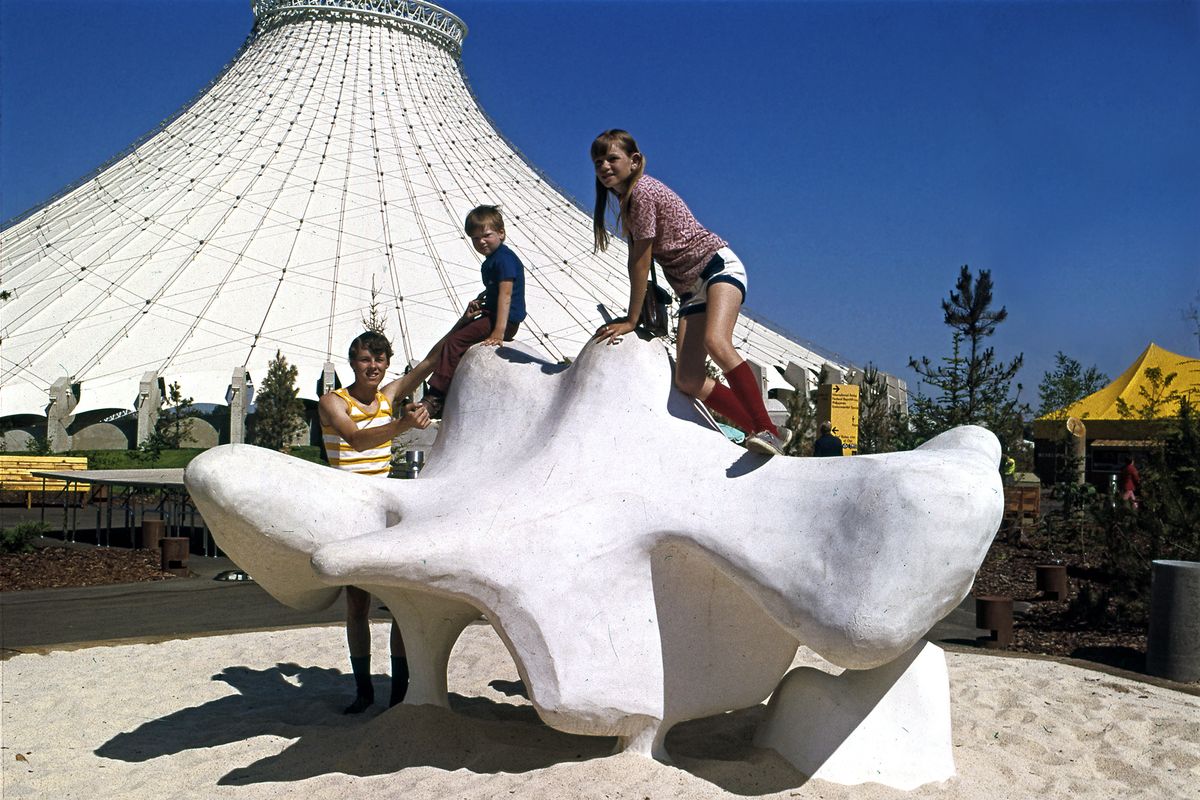Fate of Expo ’74 sculpture murky as park is revamped

A dirt lot north of Riverfront Park holds the ruins of Expo ’74.
The dismantled wings of one of the giant, welcoming butterfly sculptures from the World’s Fair lie near some weeds.
It recently was joined by another artifact built for the fair, the untitled sculpture often called “the dinosaur bone.”
The sculpture’s fate is unclear. Later this year, voters likely will consider a package of ballot measures to pay for a $60 million revitalization of Riverfront Park. Park officials say they might decide to restore the sculpture and reinstall it as part of that effort – though it would not be put back in a playground where it stood until September.
The massive concrete piece was removed out of fear that it was a danger to the kids who climbed it, said Park Director Leroy Eadie. He said park leaders will consider its future this summer and consult with the city’s Arts Commission.
Ted McGregor, who led the Riverfront Park Masterplan Advisory Committee that finalized a park revitalization plan this year, remembers playing on the dinosaur bone as a kid.
“There are not many artifacts of Expo left,” said McGregor, the publisher of the Inlander. “The ones that we want to preserve, we want to make sure they stay around. To me, it should be on the list to consider.”
The dinosaur bone was made by Charles W. Smith, a University of Washington professor who died in 2009. He was one of 15 sculptors chosen to create art for Expo ’74. The work originally was located near the center of the park and later moved to a playground on the west side of the park.
When Smith was crafting the sculpture on the Expo grounds, he was asked what it represented.
“Nothing,” he told a Spokane Daily Chronicle reporter. “It can be anything a child wants it to be.”
Three years ago, park officials said it was in disrepair and a danger to children. They planned to “recycle” it or throw it out. The city’s Arts Commission agreed to decommission it from the city’s art collection, and the Park Board voted to remove it, but staff members put their plans on hold after criticism emerged. Park officials say efforts in the past few years to find a new home for it or pay for repairs were unsuccessful. A similar Charles W. Smith sculpture in a Seattle park, however, has been restored.
City officials had said the sculpture might not survive a move, but those fears weren’t realized. The sculpture was moved with the help of a crane.
“There was no additional damage,” said Dave Randolph, the park’s facilities and grounds foreman.
McGregor said he doesn’t remember the Riverfront park committee talking about saving the dinosaur bone specifically. But the committee, in general, believed the park should retain Expo artifacts.
The dismantled butterfly is used for spare parts for the last of the four butterflies still standing in the park. The butterflies adorned the entrances to the fair. McGregor said the committee hopes a revitalized park maintains at least one butterfly.
McGregor noted that the committee’s Riverfront proposal includes a sculpture garden on the east end of Havermale Island. That might be a good place for the dinosaur bone because it would be outside a playground.
“The goal is to retain as much of the original artwork as possible,” said Councilman Mike Allen, who also serves on the Park Board. “My guess is you’ll see it again.”
Enid Smith Becker, Smith’s daughter, said she is not aware of any efforts by the city to contact the family about efforts to restore the sculpture or remove it. She said she might support placing it in a sculpture garden but would prefer that kids be allowed to climb it.
“That was dad’s original plan,” said Becker, an artist who works out of the studio her father used in Bellevue. “He was cognizant of making it aesthetically pleasing and fun for kids.”